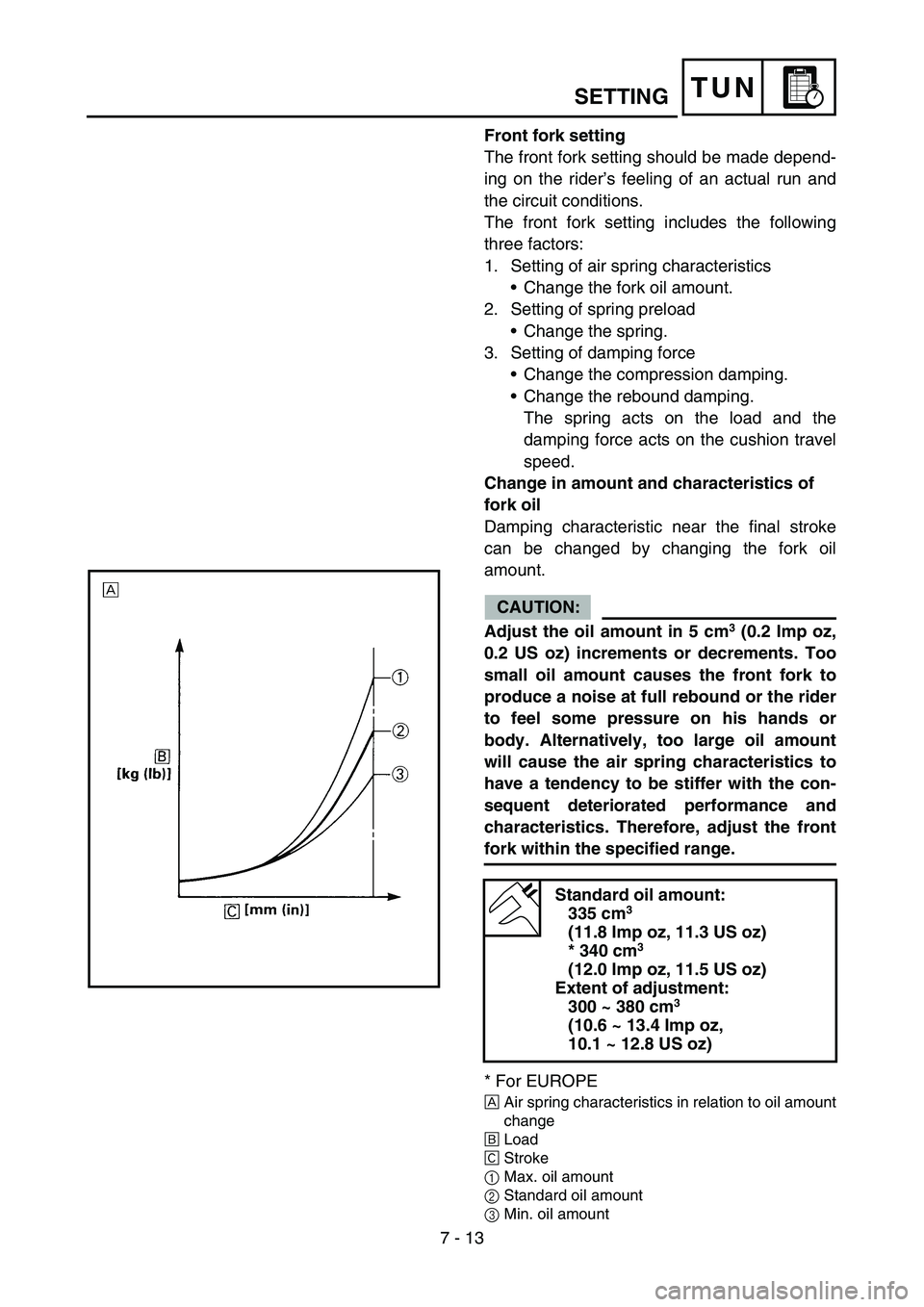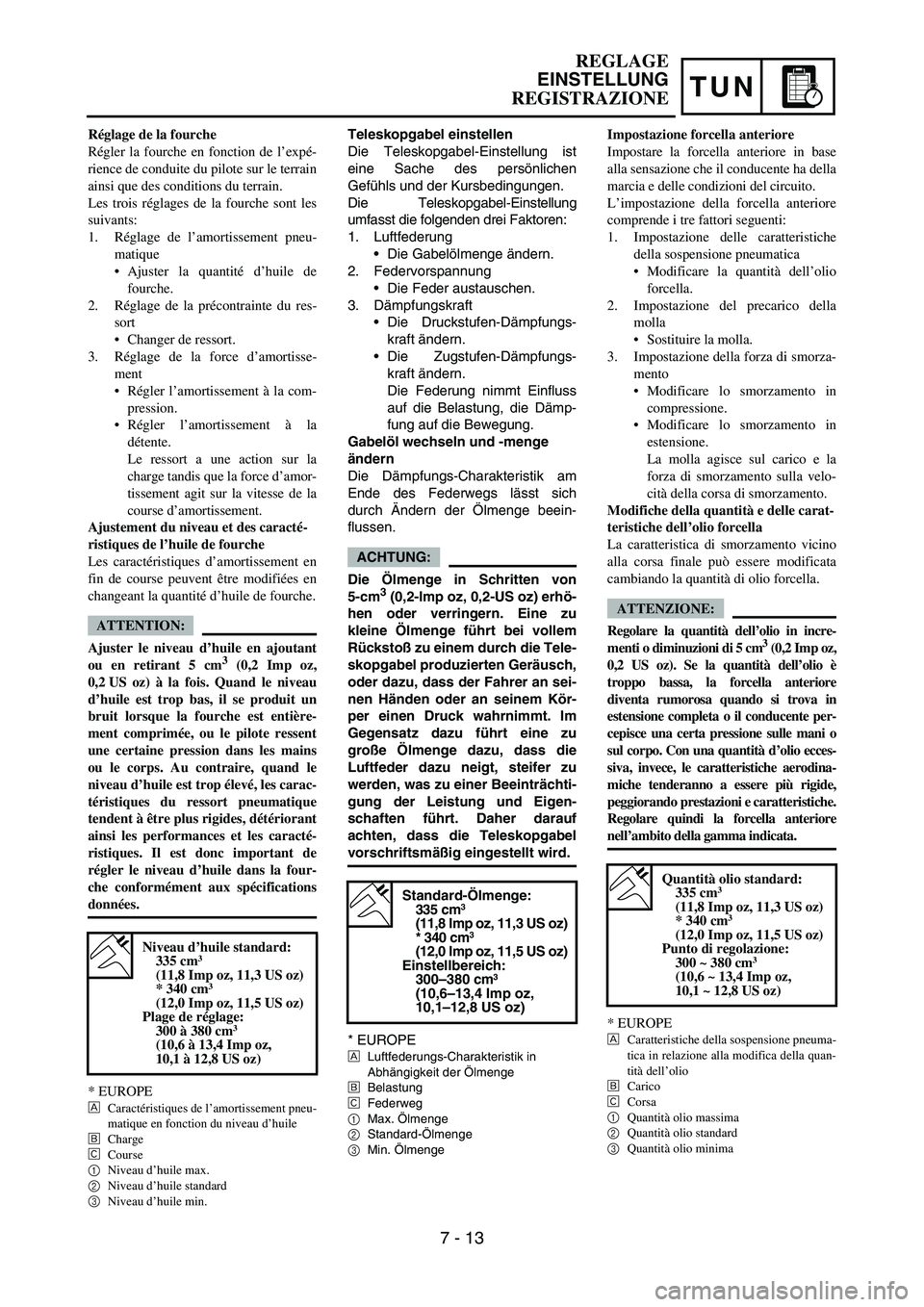air condition YAMAHA YZ250F 2006 User Guide
[x] Cancel search | Manufacturer: YAMAHA, Model Year: 2006, Model line: YZ250F, Model: YAMAHA YZ250F 2006Pages: 674, PDF Size: 21.07 MB
Page 650 of 674

7 - 13
TUNSETTING
Front fork setting
The front fork setting should be made depend-
ing on the rider’s feeling of an actual run and
the circuit conditions.
The front fork setting includes the following
three factors:
1. Setting of air spring characteristics
•Change the fork oil amount.
2. Setting of spring preload
•Change the spring.
3. Setting of damping force
•Change the compression damping.
•Change the rebound damping.
The spring acts on the load and the
damping force acts on the cushion travel
speed.
Change in amount and characteristics of
fork oil
Damping characteristic near the final stroke
can be changed by changing the fork oil
amount.
CAUTION:
Adjust the oil amount in 5 cm
3 (0.2 Imp oz,
0.2 US oz) increments or decrements. Too
small oil amount causes the front fork to
produce a noise at full rebound or the rider
to feel some pressure on his hands or
body. Alternatively, too large oil amount
will cause the air spring characteristics to
have a tendency to be stiffer with the con-
sequent deteriorated performance and
characteristics. Therefore, adjust the front
fork within the specified range.
* For EUROPE
ÈAir spring characteristics in relation to oil amount
change
ÉLoad
ÊStroke
1Max. oil amount
2Standard oil amount
3Min. oil amount
Standard oil amount:
335 cm3
(11.8 Imp oz, 11.3 US oz)
* 340 cm
3
(12.0 Imp oz, 11.5 US oz)
Extent of adjustment:
300 ~ 380 cm
3
(10.6 ~ 13.4 Imp oz,
10.1 ~ 12.8 US oz)
Page 651 of 674

TUN
Teleskopgabel einstellen
Die Teleskopgabel-Einstellung ist
eine Sache des persönlichen
Gefühls und der Kursbedingungen.
Die Teleskopgabel-Einstellung
umfasst die folgenden drei Faktoren:
1. Luftfederung
•Die Gabelölmenge ändern.
2. Federvorspannung
•Die Feder austauschen.
3. Dämpfungskraft
•Die Druckstufen-Dämpfungs-
kraft ändern.
•Die Zugstufen-Dämpfungs-
kraft ändern.
Die Federung nimmt Einfluss
auf die Belastung, die Dämp-
fung auf die Bewegung.
Gabelöl wechseln und -menge
ändern
Die Dämpfungs-Charakteristik am
Ende des Federwegs lässt sich
durch Ändern der Ölmenge beein-
flussen.
ACHTUNG:
Die Ölmenge in Schritten von
5-cm
3 (0,2-Imp oz, 0,2-US oz) erhö-
hen oder verringern. Eine zu
kleine Ölmenge führt bei vollem
Rückstoß zu einem durch die Tele-
skopgabel produzierten Geräusch,
oder dazu, dass der Fahrer an sei-
nen Händen oder an seinem Kör-
per einen Druck wahrnimmt. Im
Gegensatz dazu führt eine zu
große Ölmenge dazu, dass die
Luftfeder dazu neigt, steifer zu
werden, was zu einer Beeinträchti-
gung der Leistung und Eigen-
schaften führt. Daher darauf
achten, dass die Teleskopgabel
vorschriftsmäßig eingestellt wird.
* EUROPE
È
Luftfederungs-Charakteristik in
Abhängigkeit der Ölmenge
É
Belastung
Ê
Federweg
1
Max. Ölmenge
2
Standard-Ölmenge
3
Min. Ölmenge
Standard-Ölmenge:
335 cm3
(11,8 Imp oz, 11,3 US oz)
* 340 cm
3
(12,0 Imp oz, 11,5 US oz)
Einstellbereich:
300–380 cm
3
(10,6–13,4 Imp oz,
10,1–12,8 US oz)
Réglage de la fourche
Régler la fourche en fonction de l’expé-
rience de conduite du pilote sur le terrain
ainsi que des conditions du terrain.
Les trois réglages de la fourche sont les
suivants:
1. Réglage de l’amortissement pneu-
matique
Ajuster la quantité d’huile de
fourche.
2. Réglage de la précontrainte du res-
sort
Changer de ressort.
3. Réglage de la force d’amortisse-
ment
Régler l’amortissement à la com-
pression.
Régler l’amortissement à la
détente.
Le ressort a une action sur la
charge tandis que la force d’amor-
tissement agit sur la vitesse de la
course d’amortissement.
Ajustement du niveau et des caracté-
ristiques de l’huile de fourche
Les caractéristiques d’amortissement en
fin de course peuvent être modifiées en
changeant la quantité d’huile de fourche.
ATTENTION:
Ajuster le niveau d’huile en ajoutant
ou en retirant 5 cm
3 (0,2 Imp oz,
0,2 US oz) à la fois. Quand le niveau
d’huile est trop bas, il se produit un
bruit lorsque la fourche est entière-
ment comprimée, ou le pilote ressent
une certaine pression dans les mains
ou le corps. Au contraire, quand le
niveau d’huile est trop élevé, les carac-
téristiques du ressort pneumatique
tendent à être plus rigides, détériorant
ainsi les performances et les caracté-
ristiques. Il est donc important de
régler le niveau d’huile dans la four-
che conformément aux spécifications
données.
* EUROPE
È
Caractéristiques de l’amortissement pneu-
matique en fonction du niveau d’huile
É
Charge
Ê
Course
1
Niveau d’huile max.
2
Niveau d’huile standard
3
Niveau d’huile min.
Niveau d’huile standard:
335 cm3
(11,8 Imp oz, 11,3 US oz)
* 340 cm3
(12,0 Imp oz, 11,5 US oz)
Plage de réglage:
300 à 380 cm
3
(10,6 à 13,4 Imp oz,
10,1 à 12,8 US oz)
Impostazione forcella anteriore
Impostare la forcella anteriore in base
alla sensazione che il conducente ha della
marcia e delle condizioni del circuito.
L’impostazione della forcella anteriore
comprende i tre fattori seguenti:
1. Impostazione delle caratteristiche
della sospensione pneumatica
Modificare la quantità dell’olio
forcella.
2. Impostazione del precarico della
molla
Sostituire la molla.
3. Impostazione della forza di smorza-
mento
Modificare lo smorzamento in
compressione.
Modificare lo smorzamento in
estensione.
La molla agisce sul carico e la
forza di smorzamento sulla velo-
cità della corsa di smorzamento.
Modifiche della quantità e delle carat-
teristiche dell’olio forcella
La caratteristica di smorzamento vicino
alla corsa finale può essere modificata
cambiando la quantità di olio forcella.
ATTENZIONE:
Regolare la quantità dell’olio in incre-
menti o diminuzioni di 5 cm
3 (0,2 Imp oz,
0,2 US oz). Se la quantità dell’olio è
troppo bassa, la forcella anteriore
diventa rumorosa quando si trova in
estensione completa o il conducente per-
cepisce una certa pressione sulle mani o
sul corpo. Con una quantità d’olio ecces-
siva, invece, le caratteristiche aerodina-
miche tenderanno a essere più rigide,
peggiorando prestazioni e caratteristiche.
Regolare quindi la forcella anteriore
nell’ambito della gamma indicata.
* EUROPE
È
Caratteristiche della sospensione pneuma-
tica in relazione alla modifica della quan-
tità dell’olio
É
Carico
Ê
Corsa
1
Quantità olio massima
2
Quantità olio standard
3
Quantità olio minima
Quantità olio standard:
335 cm3
(11,8 Imp oz, 11,3 US oz)
* 340 cm
3
(12,0 Imp oz, 11,5 US oz)
Punto di regolazione:
300 ~ 380 cm
3
(10,6 ~ 13,4 Imp oz,
10,1 ~ 12,8 US oz)
REGLAGE
EINSTELLUNG
REGISTRAZIONE
7 - 13